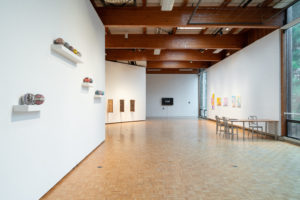Queer Paranormal at Bennington College’s Usdan Gallery
By Emily R. Bass
“Queer visuality…We may need to squint, to strain our vision and force it to see otherwise, beyond the limited vista of the here and the now.” – José Esteban Muñoz, Cruising Utopia.
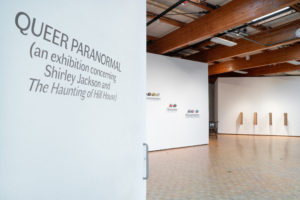
In their exhibition Queer Paranormal (an exhibition concerning Shirley Jackson and The Haunting of Hill House), curatorial collective Two Chairs draw a parallel between the spirits that haunt Shirley Jackson’s famed novel and queerness—the unusual, the alternative, the strange. In their words, “Asserting that the paranormal is queer opens up a range of possibilities in relation to its routine constituent—the normal.” Stating that the supernatural forces in Hill House are queer provides deeper insight into the role the paranormal plays in the book and in Jackson’s life.
In The Haunting of Hill House, Dr. Montague, a researcher of the paranormal, rents out Hill House for a summer and invites guests Eleanor and Theodora to stay with him to investigate the house, which is rumored to be haunted. Throughout the novel, it becomes unclear whether the paranormal phenomena is in fact manifested by the house, or if it is a product of the characters’ imaginations, indicative of their own desires.
The Haunting of Hill House was written in 1959 during Jackson’s time living in North Bennington, Vermont, where the exhibition is on view at Bennington College (through December 7). The author’s own life was haunted by an unhappiness with the heterosexual domestic ideology of her time. The stay-at-home mother and faculty wife used her writing, rife with witchcraft and supernatural entities, as a means of escaping the constraints of her everyday. “Just being a writer gives you an unassailable protection against reality,” she wrote.
Despite having two lesbian protagonists, (“emphatically not married”), The Haunting of Hill House is anything but a gay love story. Rather, the house serves as a symbol of queerness, its paranormal forces pulling Eleanor into the realm of abnormality. The exhibition was prompted by a scene in which Eleanor reaches out for Theodora’s hand, only to discover the hand she’s holding belongs to a ghost manifested by Hill House. This anticipatory current of intimacy (and resulting misaligned contact) is described by queer theorist José Esteban Muñoz as “a mode of being and feeling that was then not quite there but nonetheless an opening.” This paranoiac unsureness is all too familiar to those with queer desires—the “Is it really there?” that haunts our interactions.
Queer Paranormal (an exhibition concerning Shirley Jackson and The Haunting of Hill House) is installed throughout Bennington’s campus: in Usdan Gallery, Jennings music building, the Lens at CAPA and outdoors in the field outside Jennings. The ten artists in Queer Paranormal, working in video, sculpture and installation, explore “a range of artistic practices ‘haunted’ by historical, political and sexual difference.” Two Chairs writes, “One of our members was interested in exploring the queer past because so much has been written about queer futurity.”

In Queer Paranormal, the implicit themes in Shirley Jackson’s Haunting of Hill House are made explicit. This effort is most clear in Senem Pirler’s sound installation, Unearthly Vibrations. Through speakers installed throughout a corridor, electromagnetic energy is amplified in the form of a buzzing current, causing a vibration reminiscent of the sounds that radiate from the walls of Hill House. Their source? A recording of vibrators in a fish tank. With campy humor and cheeky frankness, Pirler makes visible the sexual undercurrents implied throughout Jackson’s novel, assigning an obvious queer source to the house’s mysterious energy.
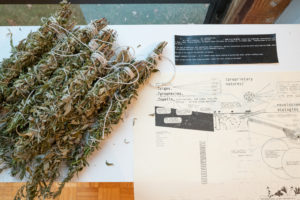
An outdoor installation by APRIORI similarly transforms Bennington’s campus into a site for the paranormal, not unlike Hill House. Notes for Haunting Properties consists of a tableau of resources, software, fieldwork findings and landscape intervention—broom-corn, flax, mugwort, rose and hawthorn labeled with stakes planted in the field outside the gallery. Prompted by a belief that plants are in silent communication with AI, the collective highlights the underlying paranormality of Bennington’s terrain, with properties existing outside human control (A poll of Bennington students identified many campus sites they believe to be haunted, including Jennings.)
Works by Sasha Wortzel and Anna Campbell explore the idea of Haunted House, Haunted Past, that is, connecting the forces that haunt Shirley Jackson’s novel to individuals and groups historically marginalized.
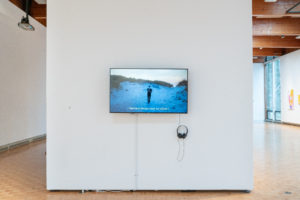
Sasha Wortzel’s We Have Always Been on Fire combines archival videos shot by queer nightlife documentarian Nelson Sullivan in 1967 before the AIDS crisis with contemporary footage depicting a popular queer gathering space on Fire Island. Her title is loaded with positive and negative connotations of queer life: David Wojnarowicz’s A Fire In My Belly, fire as a symbol of persecution tied to witchcraft, and the idea of being “on fire” when you’re dancing and full of life. The video serves as both a celebration—of safe spaces, of queer joy—and an elegy to the lives lost during the AIDS crisis. Wortzel juxtaposes these two pillars of queer history as a reminder that, yes, LGBTQ people are able to found communal spaces where they can be free, but those spaces are sadly necessitated by society’s constant relegation of queer people to the margins.
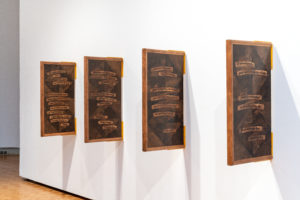
Anna Campbell, too, connects contemporary freedoms to past hardships in You know it pisses you off…, a wall installation of wooden panels covered with excerpts from Monique Wittig’s The Lesbian Body. The book’s title character, Sandy, expresses her inability to celebrate today’s welcoming LGBTQ-friendly society due to her damaging memories of less accepting times. Sandy calls to mind a period when her only safe space was the bar bathroom (a queer hookup space) where the only representation she was granted was her name “scratched on a shit-house wall.” Campbell’s wooden dividers look like bathroom stalls—a memoriam of gay bars past.
The eclectic works in Queer Paranormal embody an idea described by Olu Jenzen and Sally Munt in Paranormal and Social Change:
“It is in perception that social change begins. Being able to think or to see “otherwise” proffers imaginative forms…Because we are always other to ourselves, the paranormal pushes out what can be seen or known, and hence dynamics of alterity can take hold. Take Possession of us. Make manifest the strange. Mobilize affect and collective embodiment. Embody the spirit of change.”
By embracing the paranormal and letting it take over, these artists were able to “make manifest the strange,” to make visible the underlying currents (of race, gender, sexuality and difference) that haunt our everyday.
